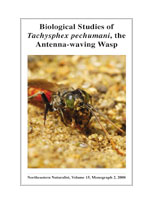This study addressed aspects of the ecology of Tachysphex pechumani (antenna-waving wasp), a rare solitary wasp. Wasps nested in compacted sand, primarily where vegetative cover was 5–30% and vegetation height was 0.5 to 33 cm. Miltogrammine flies and predators presented challenges to wasp success at the study sites. The timing and duration of T. pechumani's breeding season conformed to an apparent abundance peak of acridid grasshopper nymphs used by wasps, based on sweep-net data. Heat increased wasp activity to an upper threshold of 56 °C at the sand surface, at which temperature wasps ceased working. Weak flying abilities of both sexes suggested that populations were effectively isolated and vulnerable to habitat loss or fragmentation. Management for wasps should include maintenance of open sites and prohibition of sand disturbance.
BioOne.org will be down briefly for maintenance on 17 December 2024 between 18:00-22:00 Pacific Time US. We apologize for any inconvenience.
How to translate text using browser tools
1 March 2008
III. Ecological Observations on Tachysphex pechumani (Hymenoptera: Crabronidae)
Erin K. Moan,
Elliot J. Tramer
ACCESS THE FULL ARTICLE
<
Previous Article
|

Northeastern Naturalist
Vol. 15 • No. sp5
March 2008
Vol. 15 • No. sp5
March 2008




